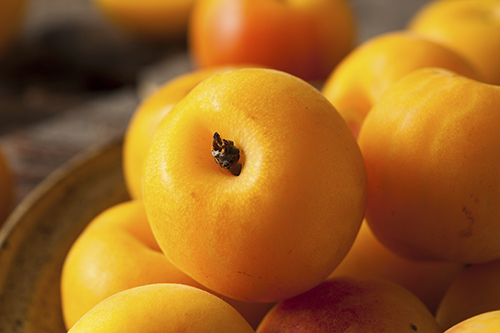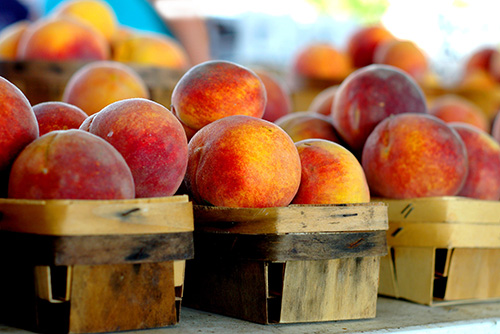140+ varieties of this “drupe” fruit are sold in the US
As part of fruits and veggies month, Thrive! is featuring fruit and veggies each week. This week and the final fruit being featured are plums. A whopping 90 percent of adults and children don’t get enough fruits and veggies, so add this one to your shopping list this week!
HISTORY
Plums are one of the first domesticated fruits in central Asia and Europe. Plums are not as old as the figs,dates, and olives of Mesopotamia but they do go back far. Plum remnants were found at Bronze Age sites in Switzerland, Hungary and England.
Also stones found at an archeological site in Dorset suggest that plums were growing in England well before the Roman conquest.
[list icon=”icon: check-square-o” icon_color=”#d81c5c”]
- The plums were among the fruits grown on Charlemagne’s ninth century royal estate in northeastern France.
- Closer to us, early colonial settlers observed native Americans enjoying wild plums that grew along the coast of Cape Cod (also known as “beach plum”).
- Plums belong to the Prunus genus of plants and are relatives of the peach, nectarine and almond. They are considered “drupes” fruits, that have a hard stone pit surrounding their seeds.
[/list]
FUN FACTS
[list icon=”icon: check-square-o” icon_color=”#d81c5c”]
- Prunes are the dried version of European plums
- In Australia there are more than 200 varieties of plums! The red-fleshed varieties have more nutrients than plums with yellow flesh, and they also have a higher sugar content and, therefore a sweeter flavor.
- Prunes are mentioned in The Winter’s Tale, the 1623 play by William Shakespeare.
- At his Mount Vernon estate, George Washington built an orchard in 1786 that included several varieties of plum trees.
- Thomas Jefferson experimented greatly with plum trees; he planted around 27 varieties in his south orchard at Monticello in the late 18th century. Unfortunately the varieties he brought over from Europe could not adapt to the humidity and heat of Virginia, and so by 1811 he only had two remaining plum trees in the orchard.
- Since the late 1990s, a barrier island on the Jersey Shore, has hosted an annual beach plum festival every September. It is located near Seaside Heights, Island Beach State Park is among a small number of remaining natural habitats of wild North American “beach plums”.
- In 2011, the “beach plum” was recognized as the official fruit of Cape May County, New Jersey.
[/list]
SEASON
Plums are a warm weather fruit and they need lots of sun but not lots of humidity. This is why they can grow in California for several months out of the year. Depending on the region, plum season can begin as early as May and go well into September. July and August are the peak plum season in most parts of the country.
August is typically when the prunes plums are harvested and dried.
ATTRIBUTES
Plums come in a wide variety of ways:
[list icon=”icon: check-square-o” icon_color=”#d81c5c”]
- Small as a cherry and as big as a tennis ball.
- Shaped like a football or squat, like a tomato.
- Shades of yellow, green, or deep red with a green streak.
- Even the flavors vary; ranging from super tart to honeyed, floral to melon.
[/list]
WHAT YOU SHOULD LOOK FOR
When looking for the right plum to purchase, no matter which type of plum, you want to be looking for ones that are taut, firm skin, and no bruising or discoloration or soft spots. When the plum yields a little pressure from your thumb that is when it is ripe. If you happen to buy an un-ripened plum it will ripen at home in a brown paper bag in the refrigerator.
NUTRITION
This juicy fruit is packed with potassium and vitamin C.
A five ounce plum contains more than two grams of fiber which is great because fiber is good for regulating blood sugar levels and feeling satiated (maybe in turn not eating as much between meals).
Plums are a natural source of sorbitol, which is a sugar alcohol which can have a mild laxative effect on the body.
STORAGE
Plums can be kept in the refrigerator, and in a paper bag if you want to let them ripen more. Plums should be eaten within a few days of purchase.
HOW TO ENJOY
Plums have a short window of season so putting them up and preserve is a great idea! You can make a:
[list icon=”icon: check-square-o” icon_color=”#d81c5c”]
- Chutney for a cheese plate or your next roast beast
- Batch of plum catsup to zip up the next grillfest
- Asian plum sauce that you can keep in the fridge or process in jars for the winter
- Plum schnapps for when it’s really cold out
- Plum jam is a great idea for gift giving as well during the holidays.
[/list]
For this summer a new and fun way to use plums is to grill up a bunch of plums, halved and pitted, and brushed with olive oil. Once they come off the heat, drizzle a touch of honey, and a squeeze of lime and some chopped basil.



